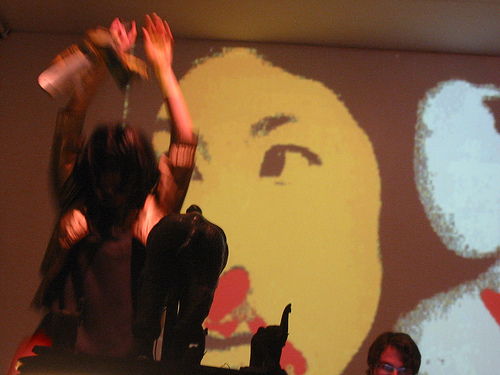
The Zoraida project is a new media performance collaboration between Nancy Garcia and Nick Hasty. As a whole, the project narrates Cuba's history and speculative future via a persona we've created named Zoraida. Zoraida's story is told through original songs, choreography, live image processing, and handmade musical instruments. In constructing Zoraida's instruments, music, and dance, we were inspired by Cuban traditions, styles and personal experience (Nancy's family and upbringing is Cuban).
The intitial phase of the project began in August 2007 and culminated in three handmade instruments and a small work-in-progress performance. We've decided the project needs an online component providing both narrative details and an alternate means for experiencing Zoraida's story for those who cannot witness the performance firsthand.
With the Rhizome Commission, we would continue developing our current instruments, initiate the project's online component, and enlist two extra performers to produce an evening-length performance.
We will propose the project to performance venues such as Dance Theater Workshop, PS 122, Impulstanz (Austria), and Danspace Project at St. Mark's Church, for potential presentation opportunities.
The Narrative
After the deaths of both Fidel Castro and his brother Raul, a puppet government backed by multinational firms was installed and set out to rebuild Cuba as a playground for wealthy tourists. A biohazardous accident, however, forced most of the firms and inhabitants off the island. With the island deemed an economic failure, the majority of the island's businesses and residents abandoned Cuba in a mass exodus to other, more profitable countries.
Yet Zoraida stayed behind. She's created her instruments out of the detritus left in the wake of the recently relocated businesses, and tours the island with an all-woman troupe using performance as a means to forge a new sound and identity out of her deserted homeland.
Prototype Instruments
Below are the working prototypes we've made for Zoraida's performance. We'd like to refine these instruments until we are satisfied with them as performative art objects.
 The Elephant Microphone utilizes four elephant statues supported by a pipe on a wooden base. A microphone is placed at the tip of the largest elephant’s trunk, and rotating each elephant controls different vocal effects via Max/MSP. These objects are heirlooms left behind by Zoraida’s family that brought good luck. With the Rhizome commission, we'd like to install a higher quality microphone, a new microcontroller, and contine working on the instrument's base and stand design.
The Elephant Microphone utilizes four elephant statues supported by a pipe on a wooden base. A microphone is placed at the tip of the largest elephant’s trunk, and rotating each elephant controls different vocal effects via Max/MSP. These objects are heirlooms left behind by Zoraida’s family that brought good luck. With the Rhizome commission, we'd like to install a higher quality microphone, a new microcontroller, and contine working on the instrument's base and stand design. This iteration of Zoraida's Drums consists of two congas drums with piezo sensors for controlling and processing video and images via Max/Jitter. The drums conceptually channel Santeria practices and the belief in orishas. Playing the drums “conjures” video of the Cuban performer La Lupe and appropriated imagery from the film “I Am Cuba.” With the Rhizome Commission, we'd like to develop a new version of this instrument. For the next incarnation, we won't be using conga drums but rather a regular drumset with piezo sensors for controlling live visuals.
This iteration of Zoraida's Drums consists of two congas drums with piezo sensors for controlling and processing video and images via Max/Jitter. The drums conceptually channel Santeria practices and the belief in orishas. Playing the drums “conjures” video of the Cuban performer La Lupe and appropriated imagery from the film “I Am Cuba.” With the Rhizome Commission, we'd like to develop a new version of this instrument. For the next incarnation, we won't be using conga drums but rather a regular drumset with piezo sensors for controlling live visuals.
 Zoraida's Machete consists of a wireless (bluetooth) accelerometer attached to a machete. Moving the machete controls a synthesizer via Max/MSP. In Afro-Cuban religion, Ogun is the orisha of technology and war and uses the machete for forging new paths. Only men are allowed to do his dance, but Zoraida's use of the machete symbolizes her assumption of this role. We want to create one machete per female dancer (3 total), and we would use the commission funds to procure extra accelerometers to build these instruments.
Zoraida's Machete consists of a wireless (bluetooth) accelerometer attached to a machete. Moving the machete controls a synthesizer via Max/MSP. In Afro-Cuban religion, Ogun is the orisha of technology and war and uses the machete for forging new paths. Only men are allowed to do his dance, but Zoraida's use of the machete symbolizes her assumption of this role. We want to create one machete per female dancer (3 total), and we would use the commission funds to procure extra accelerometers to build these instruments.